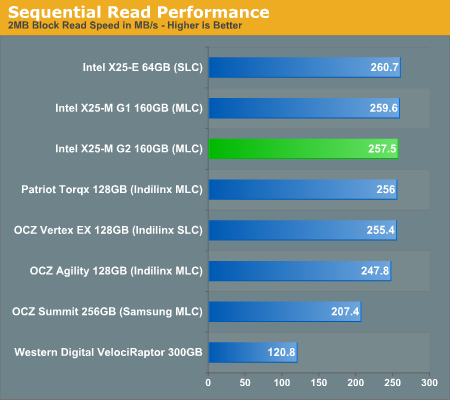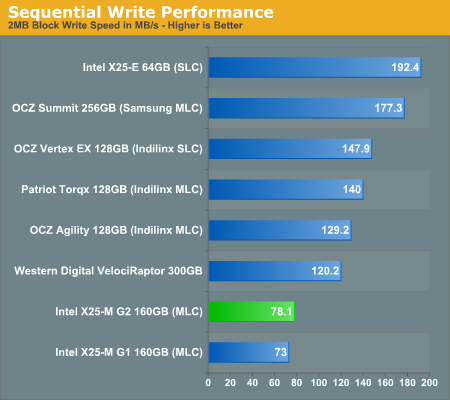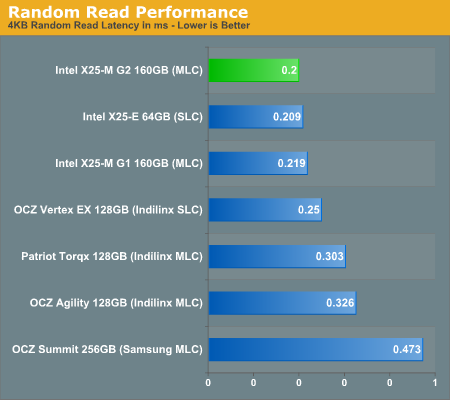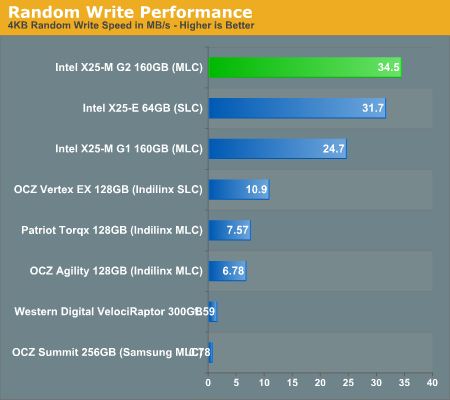Intel X25-M G2: Dissected and Performance Preview
by Anand Lal Shimpi on July 22, 2009 6:00 PM EST- Posted in
- Storage
The Performance
There are four basic pillars to SSD performance that I like to look at: random read, random write, sequential read and sequential write speed. A good SSD must be strong in all four categories, but some are more noticeable than others. Random read and write speed, particularly of small files (e.g. 4KB) are normally what make our desktop hard drives feel so slow. These random operations are everything from file and table updates to search queries and loading applications; they aren't random over the entire space of the disk but they are random enough to bring conventional hard drives to their knees.
Sequential read/write speed is what you encounter when copying large files. How quickly you can move a Blu-ray image around is determined by these values. I've run all four tests on these drives using IOMeter. I also test all SSDs in a completely used scenario where each LBA/page has been touched, at some point, with valid data. Brand new, out of the box, performance will be greater but not over the life of the drive. If you want to know more about why this is and how I test, I suggest consulting The SSD Anthology.

Sequential read performance is basically maxed out for these drives; we're bottlenecked by the SATA bus at this point (300MB/s minus some overhead). We won't see sequential read performance improve until the 6Gbps SATA protocol starts appearing in controllers. The X25-M G2 is basically the same speed as the previous gen here.

Sequential write performance has always been a bottleneck on the Intel drives. There's a small 7% performance improvement from the new drive, but it's still much slower than any other MLC drive in its class. Pushing higher speeds isn't an issue for the controller as the SLC X25-E actually posts our fastest numbers here.
While I don't believe that 70MB/s write speeds are terrible, Intel does need to think about improving performance here because the competition is already far better. The more important values are still random read/write performance, but sequential write speed is an area that Intel continues to lag behind in.

The real strength of the Intel drives is in its random, small file, read/write performance. Here we see a 10% improvement in random read performance over the 1st gen drives, putting the new X25-M ahead of even the X25-E. Now there are obvious lifespan benefits you get from an SLC drive that the G2 can't match, but for a desktop user this thing is even better than the X25-E.
None of the competitors can touch the X25-M here; Intel is 50% faster than the closest MLC contender. It's tough to read but the WD VelociRaptor scores a 0.68MB/s score here.

These are the same results as above but I'm reporting average latency instead of average transfer rate. It gives you a bit of the idea of the scale of performance here. I had to remove the WD VelociRaptor because its read latency threw the chart's scale off, it averaged 17.3 ms here.

And the X25-M G2's true strength: random write performance. Once again, we're faster than the X25-E and nearly 40% faster than the X25-M G1. None of the Indilinx or Samsung drives can touch Intel here.
The Samsung RBB controller does not seem to like worst-case random writes on a well used drive, it's actually slower than the VelociRaptor here. This is what I've seen in my earlier investigations as well. It actually helps explain why the older Samsung based SSDs in Apple notebooks never really felt all that fast.
Final Words...for now
The X25-M G2 appears to be everything Intel said it would be. It's anywhere from 0 - 40% faster than the 1st gen drive in these low level tests. I would expect to see a 0 - 10% improvement in the real world depending on applications, but that's what I'm off to test next.










87 Comments
View All Comments
pennyfan87 - Wednesday, July 22, 2009 - link
so i heard you're giving the sample away to your readers...Souka - Thursday, July 23, 2009 - link
I heard there were two samples being given away... ;)Zelog - Wednesday, July 22, 2009 - link
I'm guessing the new FLASH chips aren't BGA, then they don't need the potting. Would explain why the new controller still has it.tajmahal - Thursday, July 30, 2009 - link
well hello! Nothing like a little corruption of data is there.http://www.dailytech.com/article.aspx?newsid=15827">http://www.dailytech.com/article.aspx?newsid=15827
has407 - Sunday, July 26, 2009 - link
Take a close look at the part numbers. A bit hard to read given the resolution of the pic's, but I'd bet the old unit uses the equivalent of Micron MT29F64G08CFxxx 64Gb parts, and the new unit uses the equivalent of Micron MT29F128G08CJxxx 128Gb parts.Micron production MLC parts for both are available only in TSOP 48. The package dimensions also appear to be the same, and per ONFI 1.0 (on which Intel says they're based), that could be easily verified from the package dimensions. The controller is obviously BGA.
As to why the potting or lack of... thermal, shock, anti-whatever... but I'd guess Intel has just gotten better with the qualification/manufacturing process.
FaaR - Thursday, July 23, 2009 - link
BGA chips typically do not need potting. In fact, the vast, vast majority of BGAs - including some that run very hot - are not potted at all.If the original Intel SSD used extensive potting - I don't know myself, I've not opened up my 60GB SLC drive - I'd assume it would be as an anti-counterfiting measure to prevent far-east outfits from screwing with the innards and then selling the drives more expensively as a higher capacity unit.
Anand Lal Shimpi - Wednesday, July 22, 2009 - link
Very true, although the new controller doesn't have it to the exact same extent.Take care,
Anand